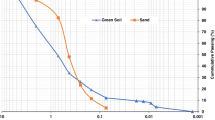Abstract
The effects of desiccation on the compressive strength of both soaked and unsoaked cement stabilized arid zone soils (sandy loam, silty loam and clay/clay loam), were investigated. The pre-drying of the stabilized clay/clay loam soils resulted in total strength loss on soaking, whereas the sandy loam soils still possess significant compressive strength which are however much lower than those obtained in the standard soaking test (i.e. without pre-drying). At higher cement contents (>10%), the calcareous silty loam soils showed slight increases in strength when pre-dried before soaking. Although the addition of 8% cement to most soils is capable of achieving the minimum compressive strength (1,720 KN/m2), and the maximum permissible strength reduction (20%) on soaking, possible desiccation of the stabilized soils under arid conditions could lead to unacceptable strength reductions when subjected to subsequent increase in moisture content. The results of this study highlight the importance of the use of various criteria, especially those simulating environmental conditions, in the evaluation of cement stabilized arid zone soils.
Résumé
Les effets de la dessication sur la résistance à la compression de sols de zones arides traités au ciment (saturés et non saturés) ont été étudiés (limons sableux, limons, argiles limoneuses, argiles). Le pré-séchage des argiles ou argiles limoneuses traitées a conduit à une perte complète de résistance à l'imbibition, alors que les limons sableux traités conservent une résistance à la compression non négligeable, bien que beaucoup plus basse que celle obtenue lors de l'essai d'imbibition standard (i.e. sans pré-séchage). Si l'on augmente les teneurs en ciment (>10%), les limons calcaires ont présenté une légère augmentation de résistance quand ils ont été pré-séchés avant imbibition. Bien que le traitement à 8% de ciment suffise pour la plupart des sols à atteindre la résistance à la compression minimale (1,720 KN/m2) ainsi que la chute de résistance maximale permise après imbibition (20%), il faut noter qu'une dessication possible des sols stabilisés dans des conditions arides pourrait conduire à des chutes de résistance inacceptables lorsqui'ils sont soumis ultérieurement à une augmentation de teneur en eau. Les résultats de cette étude montrent l'importance de la prise en compte de paramètres très variés et en particulier de ceux qui permettent de simuler les conditions réelles de l'environment lors de l'utilisation de sols stabilisés au ciment dans les régions arides.
Similar content being viewed by others
References
AKPOKODJE E.G., (1982): The Engineering-geological properties of arid zone soils and their stabilization.Unpublished Ph.d. thesis, University of New South Wales.
AMERICAN SOCIETY FOR TESTING AND MATERIALS, (1975). Special procedures for testing soil and rock for engineering purposes,Special Technical Publication. 479P. 5th ed.
BELL F.O. (1973): Climate of Fowlers Gap Station;In ‘Lands of Fowlers Gap Station’ (Mabbatt, J.A. ed.)Fowlers Gap Res., Ser. 3, 45–63. University of New South Wales.
GROFT J.B., (1968): The problem in predicting the suitability of soils for cementitious stabilization.Eng. Geol. 2 (6), 397–424.
HORTA J.C. DE O.S. (1980): Calcrete, gyprete and soil classi-fication in Algeria.Eng. Geol., Vol. 15, No. 1/2, 15–52.
STACE H.C.T., HUBBLE G.D., BREWER R., NORTHCOTE K.M., SLEEMAN J.R., MULCAHY M.J., and HALLSWORTH E.G. (1968):A Handbook of Australian Soils. Rellius, Adelaide. 518 pp.
STANDARDS ASSOCIATION AUSTRALIA (1979):Methods of testing soils for engineering purposes: As 1289 parts B-F.
Author information
Authors and Affiliations
Rights and permissions
About this article
Cite this article
Akpokodje, E.G. The importance of some environmental factors on the evaluation of cement stabilized arid zone soils. Bulletin of the International Association of Engineering Geology 28, 147–151 (1983). https://doi.org/10.1007/BF02594808
Published:
Issue Date:
DOI: https://doi.org/10.1007/BF02594808




